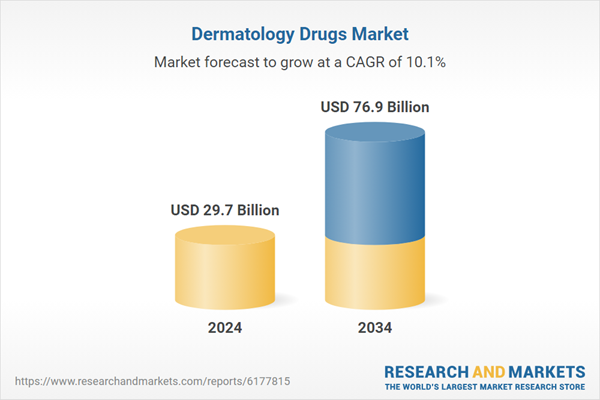This upward trend is driven by the increasing prevalence of chronic and acute skin conditions such as acne, eczema, and psoriasis, along with a growing focus on rare dermatological disorders. The market is witnessing strong momentum due to technological advances in targeted therapies, including monoclonal antibodies and small molecule inhibitors, which are delivering more effective and patient-friendly outcomes. Demand is also rising for treatments addressing drug-resistant skin diseases, which is creating space for new formulations designed to control symptoms and slow disease progression. The expanding access to care across hospitals, dermatology clinics, and home-based healthcare continues to boost drug adoption, particularly in both developed and emerging regions. Rising patient awareness, coupled with evolving consumer preference for personalized medicine, is also shaping growth. Leading pharmaceutical players are investing heavily in R&D to secure regulatory approvals and launch therapies that act on specific inflammatory or immune pathways. These efforts have strengthened the shift toward precision dermatology and optimized drug delivery platforms aimed at minimizing side effects and improving long-term patient adherence.
The anti-inflammatory therapies segment held a 32.6% share in 2024 and is projected to reach USD 25.7 billion by 2034, growing at a CAGR of 10.4%. This dominance is supported by the high efficacy of corticosteroids and non-steroidal agents in addressing a wide range of inflammatory skin disorders. These formulations offer quick relief, making them the standard approach in managing both acute and persistent conditions. As skin disorders such as atopic dermatitis and psoriasis continue to rise, the adoption of these medications increases, with most being first-line therapies in clinical practice.
The prescription drugs segment generated USD 21.2 billion in 2024. Their continued use is supported by strong clinical evidence, consistent innovation, and the development of targeted branded drugs. These therapies are central in managing moderate to severe skin conditions, especially those that require long-term treatment using biologics, corticosteroids, and antifungals. Regulatory approvals and enhanced formulations are fueling their market penetration, particularly in segments where patients require customized, ongoing medical care.
North America Dermatology Drugs Market held a 40.4% share in 2024, driven by high awareness levels, better access to advanced medical care, and an increasing number of individuals affected by chronic skin conditions. The region's growth is also being influenced by the adoption of personalized dermatological treatments, such as biomarker-based drug development and genetic profiling. Countries across the region, including Canada and the U.S., are enhancing their healthcare frameworks to improve dermatological access, aided by favorable reimbursement policies and public health outreach programs.
Key players shaping the landscape of the Global Dermatology Drugs Industry include Galderma, Pfizer, Incyte, Sanofi, Eli Lilly and Company, AstraZeneca, AbbVie, GlaxoSmithKline, Leo Pharma, Bausch Health, Dermavant Sciences, Novartis, Amgen, Johnson & Johnson, F. Hoffmann La Roche, Almirall, and Merck KGaA. To expand their presence, leading dermatology drug manufacturers are embracing multi-pronged strategies. Many are investing in next-generation biologics and gene-targeted therapies to diversify their portfolios and meet evolving treatment needs. Strategic collaborations with biotech firms and research institutions help accelerate drug discovery and pipeline development. Companies are also prioritizing geographic expansion, particularly into emerging markets with growing healthcare infrastructure.
Comprehensive Market Analysis and Forecast
- Industry trends, key growth drivers, challenges, future opportunities, and regulatory landscape
- Competitive landscape with Porter’s Five Forces and PESTEL analysis
- Market size, segmentation, and regional forecasts
- In-depth company profiles, business strategies, financial insights, and SWOT analysis
This product will be delivered within 2-4 business days.
Table of Contents
Companies Mentioned
The companies profiled in this Dermatology Drugs market report include:- AbbVie
- Almirall
- Amgen
- AstraZeneca
- Bausch Health
- Dermavant Sciences
- Eli Lilly and Company
- F. Hoffmann La Roche
- Galderma
- GlaxoSmithKline
- Incyte
- Johnson & Johnson
- Leo Pharma
- Merck KGaA
- Novartis
- Pfizer
- Sanofi
Table Information
| Report Attribute | Details |
|---|---|
| No. of Pages | 140 |
| Published | September 2025 |
| Forecast Period | 2024 - 2034 |
| Estimated Market Value ( USD | $ 29.7 Billion |
| Forecasted Market Value ( USD | $ 76.9 Billion |
| Compound Annual Growth Rate | 10.1% |
| Regions Covered | Global |
| No. of Companies Mentioned | 18 |









